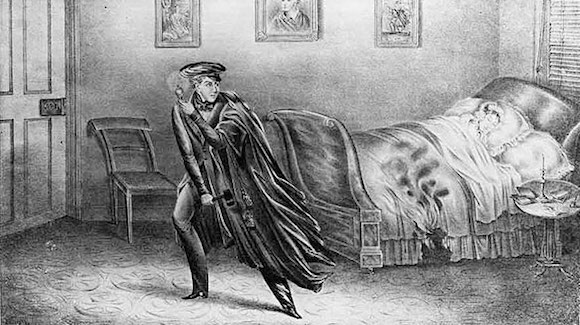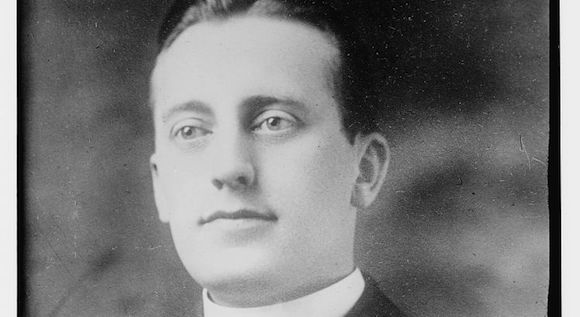Love Me Not: 10 Infamous Crimes of Passion in NYC
By Eve Karlin

An illustration of the murder scene from a pamphlet. With hatchet in hand, Richard P. Robinson in on the left.
Editor's Note: Eve Karlin was born and raised in New York City. She is a graduate of Colgate University, where she studied literature and creative writing. City of Liars and Thieves is her first book. For Biographile, Karlin recounts some of the most famous crimes of passion in New York City that should ease the sorrows of any Valentine's Day brooders.
In the week leading up to Valentine’s Day, it seems that every website and television ad is touting undying love—teddy bears and lingerie for your sweetheart, romantic restaurants, and ads for 1-800-flowers—but being in a relationship might not be all it’s cracked up to be. In a year when Friday the 13th falls the day before Valentine’s, maybe we should take a moment and think about what could go wrong. Love may not be forever.
1. Elma Sands (December 22, 1799): In December 1799, a raven-haired beauty named Elma Sands vanished on the snowy streets of New York City. Twelve days later, Elma’s corpse was found floating in an abandoned well, and her lover, Levi Weeks, was arrested for murder. While the brutal slaying of an innocent girl rocked the city, it was Levi Weeks’ trial that made the case truly sensational. Weeks was defended by Alexander Hamilton and Aaron Burr four years before their infamous duel.
2. Helen Jewett (April 10, 1836): Helen Jewett, a New York prostitute, was murdered at a brothel at 41 Thomas Street. Her head had been smashed in and her bed set on fire. A patron, Richard Robinson, was charged with murder. Most of the evidence against Robinson was circumstantial and the majority of witnesses were prostitutes. The judge ordered the jury to discount their testimony, and they returned with a not guilty verdict in less than a half hour.
3. Mary Cecilia Rogers (July 28, 1841): Mary Rogers, referred to as the "beautiful cigar girl" because she worked in a tobacco shop, told her fiancé that she was going to visit relatives. Three days later, police found her corpse floating in the Hudson River near Hoboken, New Jersey. Popular opinion was that she was murdered by a gang or dumped after a failed abortion. During the inquest, her fiancé committed suicide. The unsolved case is the basis for Edgar Allan Poe’s story "The Mystery of Marie Roget."
4. Stanford White (June 25, 1906): Multimillionaire Harry Kendell Thaw murdered renowned architect Stanford White on the rooftop of the original Madison Square Garden, which White designed. White had been having an affair with Thaw’s wife, Evelyn Nesbit, a celebrated beauty, chorus girl, and model. Thaw’s trial was known as "the trial of the century." Due to the publicity maelstrom, jurors were sequestered for the first time in American history. The trial lasted nearly three months. After forty-seven hours of deliberation, the jury emerged deadlocked. At the second trial, Thaw was found not guilty by reason of insanity and was sentenced to life in prison. The story was immortalized in the 1955 movie "The Girl in the Red Velvet Swing."
5. Anna Aumuller (September 2, 1913): Anna Aumuller was a recent Austrian immigrant to New York City working as a housekeeper at the rectory of St. Boniface Church at 2nd Avenue and 47th Street. She had a love affair with the church’s Roman Catholic priest, Hans Schmidt. The pair were "married" in a secret ceremony which Schmidt performed. After discovering Anna was pregnant, Schmidt slashed her throat, dismembered her body, and dumped the pieces into the East River. On February 18, 1916, Schmidt was sent to the electric chair at Sing Sing Prison. He is the only priest ever executed for murder in the United States.

6. Dorothy "Dot" King, the "Broadway Butterfly" (March 15, 1923): Dot King, also known as the "Broadway Butterfly" because of her incipient career as an artist model and Broadway showgirl, was found dead in her apartment at 144 West 57th Street. She was discovered by her maid, who stumbled over two fur coats strewn on the floor before coming across Dot’s lifeless body. The victim was lying in bed with her head under a pillow, one arm bent back under her body, and the other reaching out. An empty chloroform bottle lay at the foot of the bed. The first policeman at the scene called the death a suicide, but other clues hinted to something more sinister. The telephone was found not in its usual place, but stretched to the end of its cord in another room -- out of arm’s reach. A man’s pocket comb was found on the floor. Dot’s jewelry was missing. Did Dot King kill herself? Was she murdered by her young, physically-abusive lover? Or by a jealous, wealthy benefactor ("heavy sugar" was the contemporary colloquialism) with whom she had dined the night before? The "Broadway Butterfly" murder was never solved.
7. Starr Faithful (June 8, 1931): In June 1931, 25-year-old Starr Faithfull’s body washed up on Long Beach, Long Island. Molested at an early age, Starr lived a troubled life. After spending time in sanitariums and abroad in Europe, she took up residence in Greenwich Village. It was the era of Prohibition, and she became a regular in the local speakeasies. On the night of June 5, 1931, Starr did not return home. Three days later a beachcomber found her battered corpse. The medical examiner believed the bruises had been caused by blows. Sand was found in Starr’s throat, an indication that she had been drowned in shallow water. An autopsy revealed a considerable amount of Veronal, a tar-based barbiturate, in Starr’s system. Starr’s diary detailed her wild life and numerous affairs, but the case has never been solved. It is the basis for the 1960 film "Butterfield 8," starring Elizabeth Taylor.
8. Nancy Spungen (October 12, 1978): Nancy Spungen, the girlfriend of Sex Pistols bassist Sid Vicious, was found dead from a stab wound to the abdomen at the Chelsea Hotel. The Chelsea is a legendary residence/artist’s colony that has been home to Jackson Pollock, Dylan Thomas, Arthur Miller, Bob Dylan, Andy Warhol and more. Vicious, who had been living with Spungen in Room 100 was charged with murder. He died of a heroin overdose before the trial and the case was closed. Chelsea Hotel is often cited as one of New York City’s most haunted locations. People report hot and cold spots, unexplained gusts of wind, and shadowy figures looming the halls. Some claim to have seen the ghost of Nancy Spungen.

9. Jennifer Levin (August 26, 1986): Robert Chambers, nicknamed the "Preppie Killer," murdered 18-year-old Jennifer Levin. The pair had been seen leaving an Upper East Side bar together. Early the next morning, Jennifer’s half-naked corpse was found in Central Park. Chambers was charged with murder. In court, lawyers argued he had accidently strangled Jennifer during “rough sex.” During the media frenzy, Levin’s reputation was skewered while Chambers was described as a "preppie altar boy." A plea bargain was struck after the jury was deadlocked. Chambers plead guilty to manslaughter and received five to fifteen years. Released in 2003, he was arrested again on unrelated drug charges. His earliest release date is in 2024.
10. Sylvie Cachey (December 9, 2010): 33-year-old swimsuit designer Sylvie Cachey was found dead, submerged in the bathtub of boyfriend Nick Brook’s Soho House room. The couple had a tumultuous on-again off-again romance. Brooks claimed he was downstairs having a drink in the bar at the time of Cachey’s death. A half-empty bottle of prescription pills was found near Cachey’s body. She had red marks on her neck, bite marks on her hands and bleeding from her eyes. The New York City medical examiner determined that she had died from being strangled and held under water. Brooks, who tabloids labeled a "trust fund playboy," was convicted of second-degree murder. He is serving twenty-five years to life.
